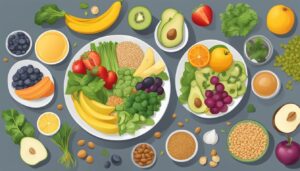Introduction
Healthy cooking doesn’t have to mean sacrificing flavor or satisfaction. With the right techniques and substitutions, you can lighten up your favorite meals without compromising on taste. In this article, we’ll explore a variety of healthy cooking hacks to help you create delicious and nutritious dishes that support your health and wellness goals.
Understanding Healthy Cooking Hacks
Explanation of Healthy Cooking Hacks
Healthy cooking hacks are simple yet effective strategies that can help you prepare nutritious meals without sacrificing flavor or satisfaction. These hacks often involve making small adjustments to traditional recipes or cooking methods to enhance the nutritional value of your meals while reducing excess calories, unhealthy fats, and sodium. By incorporating healthy cooking hacks into your culinary repertoire, you can enjoy delicious food that supports your overall health and well-being.
Benefits of Lightening Up Meals
Lightening up meals by reducing the amount of added fats, sugars, and processed ingredients can offer numerous health benefits. By opting for lighter cooking techniques such as grilling, steaming, or baking instead of frying, you can lower the calorie and fat content of your meals while preserving their natural flavors and nutrients. Incorporating more fruits, vegetables, whole grains, and lean proteins into your diet can also help increase the fiber, vitamins, and minerals in your meals, promoting better digestion, weight management, and overall health. Lightening up meals can lead to improved energy levels, better mood, and a reduced risk of chronic diseases such as heart disease, diabetes, and obesity.
Introduction to Various Cooking Techniques and Substitutions
There are many cooking techniques and substitutions that can help you prepare healthier meals without sacrificing taste or texture. Some popular cooking techniques include:
- Grilling: Grilling meats, poultry, fish, and vegetables can impart delicious smoky flavors without the need for added fats or oils.
- Steaming: Steaming is a gentle cooking method that helps preserve the natural nutrients and flavors of foods, making it an excellent option for vegetables, seafood, and grains.
- Roasting: Roasting vegetables and meats in the oven can caramelize their natural sugars, resulting in rich flavors and crispy textures without the need for excessive oils or fats.
- Sauteing: Sauteing vegetables, tofu, or lean meats in a small amount of olive oil or broth can add depth of flavor without loading up on unhealthy fats.
In addition to these cooking techniques, there are various substitutions you can make to lighten up your meals:
- Replace refined grains with whole grains like brown rice, quinoa, or whole wheat pasta for added fiber and nutrients.
- Swap out creamy sauces and dressings for lighter alternatives such as Greek yogurt, hummus, or homemade vinaigrettes made with olive oil and vinegar.
- Use herbs, spices, citrus juices, and vinegars to add flavor to your dishes without relying on salt or excessive amounts of sugar.
- Choose lean cuts of meat, poultry, and fish and trim off any visible fat before cooking to reduce the overall calorie and fat content of your meals.
By experimenting with these cooking techniques and substitutions, you can transform your favorite recipes into healthier versions that are both delicious and nutritious.
Hacks for Lightening Up Breakfast
Using Greek Yogurt Instead of Cream or Butter in Recipes
One effective hack for lightening up breakfast is to replace high-fat ingredients like cream or butter with Greek yogurt. Greek yogurt is rich in protein, calcium, and probiotics, making it a nutritious alternative that adds creaminess and tanginess to your favorite breakfast recipes. Whether you’re making pancakes, muffins, or baked goods, substituting Greek yogurt can help reduce the overall calorie and fat content of your breakfast without sacrificing taste or texture. Plus, it provides a satisfying boost of protein to keep you feeling full and energized throughout the morning.
Incorporating Vegetables into Breakfast Dishes like Omelets and Smoothies
Another smart hack for lightening up breakfast is to incorporate vegetables into your morning meals. Adding veggies like spinach, bell peppers, tomatoes, mushrooms, or onions to omelets, frittatas, or scrambled eggs not only boosts the nutritional value of your breakfast but also adds flavor, texture, and color. Vegetables are low in calories and packed with essential vitamins, minerals, and antioxidants, making them an excellent choice for starting your day on a healthy note. You can also sneak vegetables into breakfast smoothies by blending them with fruits, yogurt, and other nutritious ingredients for a refreshing and filling morning drink.

Choosing Whole Grain Options for Breads and Cereals
Opting for whole grain options for breads and cereals is another effective hack for lightening up breakfast. Whole grains like oats, whole wheat, barley, and quinoa are rich in fiber, vitamins, and minerals, making them a healthier choice compared to refined grains. Look for whole grain breads, bagels, English muffins, and cereals with minimal added sugars and ingredients to fuel your morning with long-lasting energy and nutrients. You can also experiment with making your own homemade granola or overnight oats using whole grain oats, nuts, seeds, and dried fruits for a customizable and nutritious breakfast option.
By incorporating these hacks into your morning routine, you can enjoy lighter, healthier breakfasts that provide essential nutrients to fuel your day without weighing you down. Whether you’re looking to cut calories, boost nutrition, or simply add more variety to your breakfast repertoire, these simple strategies can help you achieve your health and wellness goals.
Hacks for Lightening Up Lunch
FAQs
Q: What are healthy cooking hacks?
A: Healthy cooking hacks are simple tricks and tips to lighten up meals by reducing calories, fat, and unhealthy ingredients while maintaining flavor and nutrition.
Q: How can I make my favorite meals healthier?
A: You can make your favorite meals healthier by substituting high-fat ingredients with healthier alternatives, increasing the use of herbs and spices for flavor, and incorporating more fruits and vegetables into recipes.
Q: What are some examples of healthy ingredient substitutions?
A: Examples of healthy ingredient substitutions include using Greek yogurt instead of sour cream, whole wheat flour instead of white flour, and olive oil instead of butter.
Q: How can I reduce the calorie content of my meals?
A: You can reduce the calorie content of your meals by opting for cooking methods like baking, grilling, or steaming instead of frying, and by using smaller portions of high-calorie ingredients like cheese and oil.
Q: What are some ways to add flavor to meals without adding extra calories?
A: You can add flavor to meals without adding extra calories by using herbs, spices, citrus zest, and vinegar, as well as by incorporating flavorful ingredients like garlic, onions, and ginger.
Q: How can I make my meals more nutritious without sacrificing taste?
A: You can make your meals more nutritious without sacrificing taste by focusing on whole, unprocessed foods, such as lean proteins, whole grains, and plenty of fruits and vegetables, and by experimenting with different cooking techniques and flavor combinations.
Conclusion
Healthy cooking hacks are a simple and effective way to lighten up your favorite meals and improve your overall health and well-being. By incorporating these tips and tricks into your cooking routine, you can enjoy flavorful and satisfying dishes while nourishing your body with wholesome ingredients. So why not give these hacks a try and discover just how delicious and nutritious healthy cooking can be? With a little creativity and experimentation, you’ll be well on your way to creating meals that are both good for you and utterly delicious.



